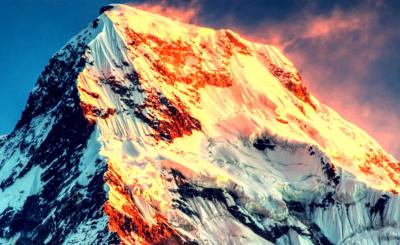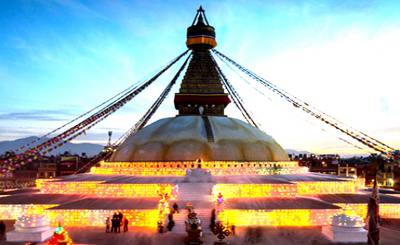The Highest Mountain in the World
THE HIGHEST MOUNTAIN IN THE WORLD
Top of the World! The statement itself oozes of thrill, excitement, and adventure. Even more illustrious is when one embarks the journey culminating in raptures succeeding numerous arduous and challenging climbs. A dream shared by many; the Mt. Everest (8848m) demands the rigors and toil of the utmost degree and yet is the epitome of astounding adventure.
WHERE IS MOUNT EVEREST LOCATED IN THE WORLD?
Mount Everest lies between the border separating Nepal and Tibet in the Mahalangur section of the Great Himalayas. Until 1852, no one had referred Everest as the highest point in the world, then the British-led Survey of India determined that Mount Everest was indeed the highest mountain in the world. As there were few local names, but there wasn’t an actual name that would identify the mountain to the world. So in 1865, the mountain was given its English name by Andrew Scott Waugh, after Welsh surveyor Sir George Everest, who served as surveyor general of India. The Nepalese call it Sagarmatha (head of the sky) and is referred to as Chomolongma (Mother Goddess of the Universe) by the Tibetans.
HISTORY OF MOUNT EVEREST
The formation of the Mount Everest was by the movement of the Indian tectonic plate over and against the Asian tectonic plate, now stands tall with the elevation of 8848m. The mountain is already over 60 million years old.
WEATHER IN MOUNT EVEREST
The cold weather of Mount Everest makes it rare for any plants or animals to survive. The average temperature in the warmest season (July) is only about -2°F (-19°C) and in the coldest month (January) the average temperature falls to −33 °F (−36 °C) and can even fall to −76 °F (−60 °C). As glaciers and snow cover the Everest all season, there are also chances of unexpected strong winds. This wind can blow over 200 mph and is strong enough to blow off the snow and rocks. This can cause serious problem to trekkers and the climbers.
MOUNT EVEREST CLIMB
The people living in these areas are usually Sherpas, although one can find people of Rai and Magar communities as well. Originally Sherpas were immigrants of Eastern Tibet who came to settle in the Himalayas of Nepal. They have been known as excellent climbers of mountains and usually work as a guide for mountain climbing and expeditions. Sherpa people are proud, courageous, and even put their lives at risks in journeys to the Himalayas. One common thing about Sherpa is their names. Usually, they are named after the days of the week, so most of them have similar names. People from a different background, ages and countries have already made it up to the Mount Everest. The first ever attempt was made by British climbers George Mallory and Sandy Irvine in 1921 from the north side. But still, it isn't sure if they reach the summit. The history was made on May 29, 1953, when Sir Edmund Hillary from New Zealand and Tenzing Norgay Sherpa from Nepal made the first ever summit. Since then, there have been 8,306 summits of Everest through June 2017 by 4,833 different people. The youngest one to summit the mountain was Jordan Romero at the age of 13 years on 11 May 23, 2010. Whereas, Japanese Muira Yiuchiro was the oldest one at the age of 80 to summit the mountain on May 23, 2013.
DEATH AND CASUALTIES DURING MOUNT EVEREST CLIMB
As the altitude goes over 8000m, there is little oxygen which makes it difficult to breathe. Usually, mountain climbers take supplemental oxygen but only 208 climbers have summited without it through June 2017. Evident from the experiences climbers face on the journey, it can be stated that the scaling of the Mt. Everest (8848m) is no easy feat. There have been deaths and still can find dead bodies lying on the mountain. 288 people (173 westerners and 115 Sherpas) have lost their lives on Everest from 1924. The leading causes of death were from an avalanche, fall, altitude sickness, and exposure to snow and extreme cold. But, in recent years, there have been reductions in death which could be the result of advanced equipment, experienced guides, and weather forecasting.
BASE OF MOUNT EVEREST
Yet, the astounding adventure to the top of the world begins from a meager altitude of 1300 from Kathmandu. A scenic flight to Lukla, Khumbu entails views of the mesmerizing parade of the Himalayas in the country. The Lukla airport is often times referred to as ‘World’s most dangerous airport' but it is the most popular trail-head to the Everest realm. From Lukla, climbers trek upward to the village of Namche Bazaar (3,440m). It takes about two days to reach the village, which is a common hub for acclimatization. They, then, trek further to Dingboche (4,260m). Another two days to finally reach to Everest Base Camp via Gorakshep. To see the clear views of the Everest (8848m) and other esteemed peaks in the Everest Vista, the trek from Gorakshep to Kalapatthar is recommended. Everest brings together many trekkers and climbers from all around the world solely credited to the intimidation that the peak possesses and sheer beauty that beckon signals of adventure. Some come to enjoy the sights of the mountain from its base whereas some dare to climb the summit. For this reason, Everest always remains tall and preserves its glory from the top of the world.
Recent Post
-

The Massive Annapurna Himalayan Range
Annapurna Region -

Northeast region of Nepal
Everest Region -

Why Veg food is the Best Option on a High-Altitude Trek?
Trekking in Nepal -

North and South of the Massive Annapurna Range in the Himalayan Mountains
Annapurna Region -

Best Way to Explore Famous Peak in Himalayas
Trekking in Nepal -

Everest Base camp Trek
Trekking in Nepal -

Welcome to Nepal Spring
Nepal Trip -

Annapurna Base Camp Trek: Route, Cost, and Key Essentials
Annapurna Region -

Best Nepal Tour Package
Tour in Nepal -

The-Best-Nepal-Tour
Tour in Nepal

